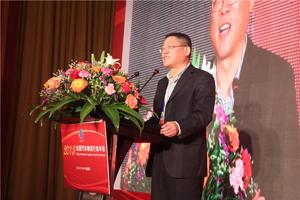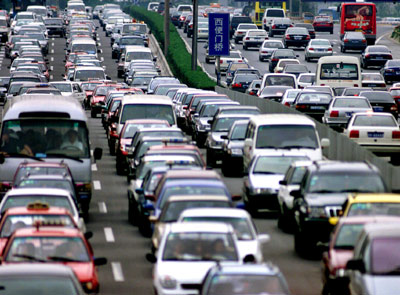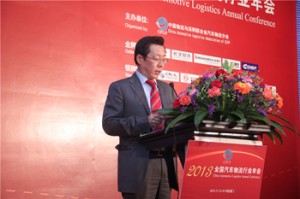As sales look set to boom, the need for efficient logistics solutions has never been greater in China, but how can supply best meet demand?

However, according to speakers at the annual meeting of the Chinese Automotive Logistics Association (CALA), a branch of the China Federation of Logistics and Purchasing (CFLP), the supply chain could face bottlenecks in operations and costs without further advances in multimodal services and transport reform, including agreement for an industry standard over truck lengths for car transporters. Increasing regulation and social pressures to reduce emissions and pollution in China will also be important to the sector.
“Automotive logistics services are rising, and we mostly provide good services in China,” said Wei Yong (pictured upper left), chief of the transport and logistics division at the National Development and Reform Commission, speaking at the conference in Xiamen City. “But there are underlying problems, including a lack of multimodal transport, and commercial vehicle lengths that are not in line with regulations and which pose security risks.”
The conference was held shortly after an important internal congress of the central government – the third plenum of the 18th central committee – in which a number of market and social reforms were announced. Speakers agreed that the changes would be important to automotive logistics, although just how much would be dependent on the speed and pace of reform.
"The market is now viewed as a ‘decisive’ factor in economic development, which gives us a direction for economic stability and for innovation" - Zhao Fang Kuan, FAW Group
“The third plenum was even more important this year, as it put emphasis on transformation and reform,” said Zhao Fang Kuan, from Chinese automotive conglomerate FAW Group. “The market is now viewed as a ‘decisive’ factor in economic development, which gives us a direction for economic stability and for innovation.”
Read here for an analysis of potential impacts on Chinese automotive logistics.
 Years of harvest to come
Years of harvest to come
After two years of more moderate increases in vehicle sales, China’s car market is once again expanding rapidly, with passenger car sales in the first ten months of this year up more than 15% to 14.5m units, with similar numbers for production, according to the China’s carmaker association (CAAM). The commercial vehicle market is up 7.5% to 3.36m sales, with production up 8.5% to 3.3m. Total vehicle sales this year could approach 22m units.
Yu De, managing director for one of China’s largest logistics firms, Anji Automotive (owned by SAIC), also pointed to a 58% reading in the CFLP purchasing index as another sign of momentum in the sector. “This year will be a year of harvest for logistics,” said Yu, who is the rotating president of CALA this year.
Xu Changming, director of the resources and information department of China’s State Information Consultancy Centre, said that the government now believes the passenger car market will continue to grow at 10% or more per year for the rest of the decade, reaching 27m cars by 2019, and 40m including the second-hand car market. The growth rate is not expected to moderate until after 2023.
Those predictions are slightly more ambitious than other market forecasts. IHS Automotive, a forecasting and analysis firm, has predicted the light vehicle market (which includes both passenger cars and light commercial vehicles) will grow at close to 10% for the next three years, before moderating in 2016, and reaching 30m in 2020. “The passenger car market will grow faster, however,” Wang Zeng, senior analyst for China vehicle sales forecasts, told Automotive Logistics.
Xu said that the government’s analysis was based partly on the developments of the Japanese and South Korean automotive markets, each of which saw rapid expansion as
their populations shifted from low to high levels of car ownership. For Japan, the growth lasted eight years at 22% per year, while in Korea the growth was 11% for 11 years. For China, Xu predicted that, dating from 2009, the growth in China would continue for 15 years at 13-15% per year, lasting longer and at a stable rate in part because of economic development across the country.
“In the first rapid growth phase, car ownership growth has been mainly in eastern part of China,” he said. “For the second phase this will increase in the central regions, and after nearly twenty years, it will grow to the western parts.”
A noxious form of growth
Xu noted that this growth has contributed to a considerable increase in pollution and noxious emissions in China. He said that China would need to curb its emissions by 50% to reverse the pollution trends. The central government has already taken measures to limit vehicle and freight traffic in response to high level of particulate matter. But cities and provinces have implemented these restrictions in different ways and timescales, he said.
However, Xu’s predictions accounted for measures by the government to curb pollution, including restrictions on purchases and vehicle use by a number of Chinese cities.
“One of the reasons that we think passenger car growth is higher than we initially expected this year is because some people have pulled forward purchases in anticipation that more cities, such as Beijing and Guanghzou, will impose restrictions,” he said.
Demand surpassing logistics supply

Automotive growth has also propelled the logistics industry. However, Xu pointed out that China’s freight sector was inefficient, requiring double the resources relative to the American economy, for example. Bottlenecks in the logistics sector were likely to restrain its growth. “In the near future we believe that transport intensity will remain high but it will be moderately reduced, falling short of GDP growth,” he said.
Zhang Zhen Peng, president of Beijing Changjiu Logistics, a large, private operator, warned that logistics supply was falling behind demand for logistics. “The question is how to conduct modular and tailor-made designs to increase our logistics capacity,” he said.
“In the near future we believe that transport intensity will remain high but it will be moderately reduced, falling short of GDP growth" - Xu Changming, China’s State Information Consultancy Centre
Many of the problems discussed among executives and officials at the event have been familiar themes for the CFLP – which partners with Automotive Logistics for the annual Automotive Logistics China conference – such as a lack of multimodal logistics and a lag in IT systems. Anji’s Yu De also pointed to rising energy, labour and warehouse costs as challenges for the sector, along with the nagging issue over car carrier lengths.

The latter issue on carrier length has been a problem in China for the past decade, where the official length of 16.5 metres – which is relatively short compared to American and most European standards – is enforced haphazardly, leading many companies to pull trailers that are dangerously longer. One manager for a German carmaker in China described some of the trucks on Chinese roads to Automotive Logistics as “aircraft carriers”, which sometimes carry around 30 cars. Fines for overloading are typically built into carriers’ rates.
“We need to set up standards for car transporters that have long been limiting this industry. We can’t go on factoring fines into our profits,” said Zhao Fang Kuan, from Chinese automotive conglomerate FAW Group.
Ma Zengrong, secretary general of CALA, said that the CFLP was working closely with the government to development a standard for car transporters that would be acceptable to industry.
NDRC’s Wei promised that his department would also unveil further reforms to cut logistics costs and increase standards. “The NDRC will pay its role as an economic regulator. We will do a series of reforms to cut the logistics costs, and identify standards to share in the sector.”
Slow pace on the tracks
Wei and Zhao also called for more multimodal and railway logistics for automotive. China is in the midst
of a number of reforms for the railways that should result in more private investment and access to the market outside the government-owned monopoly. Such progress has been slow, although the use of rail for automotive has increased.
Zuo Guangyu, vice general manager for the China Railways Special Cargo Automobile Company, a branch of China’s railways that was set up to specialise in automotive, said the company would move 1.2m vehicles this year, which is up about 50% in two years. The company currently runs 11 sites for vehicles and has an estimated 5,000 wagons. “We expect to have 6,000 wagons by the end of next year and 7,000 in two years time,” he said.
 Despite this growth, speakers acknowledged that the market needed further reforms to open rail and other modes of transport. “The progress for rail is somewhat embarrassing,” admitted Zhang Xiadong, a professor in transport at Beijing Jiatong University. But aside from the need for market reform, he said that there were gaps in infrastructure between different modes in China, such as between car factories and ports.
Despite this growth, speakers acknowledged that the market needed further reforms to open rail and other modes of transport. “The progress for rail is somewhat embarrassing,” admitted Zhang Xiadong, a professor in transport at Beijing Jiatong University. But aside from the need for market reform, he said that there were gaps in infrastructure between different modes in China, such as between car factories and ports.
Although most executive agreed that automotive logistics faced many challenges in China, many also said that the sector was highly advanced compared to other parts of the economy or to other logistics industries. “Industrial and finance logistics are taking shape,” said Yu from Anji. “Logistics technology has been widely applied, and we’ve increased the output of equipment.”

























![Global[1]](https://d3n5uof8vony13.cloudfront.net/Pictures/web/a/d/s/global1_726550.svgz)









